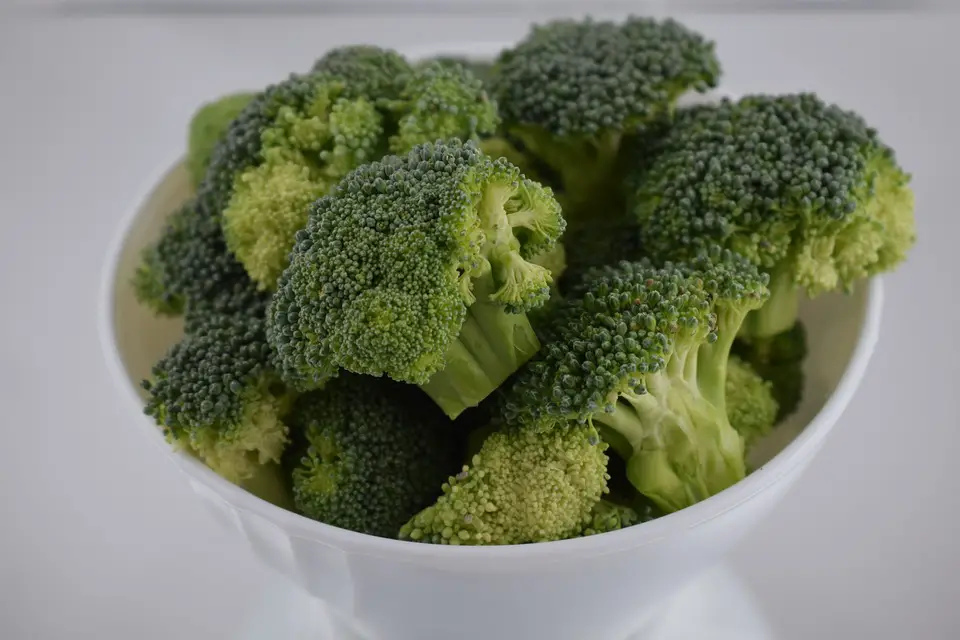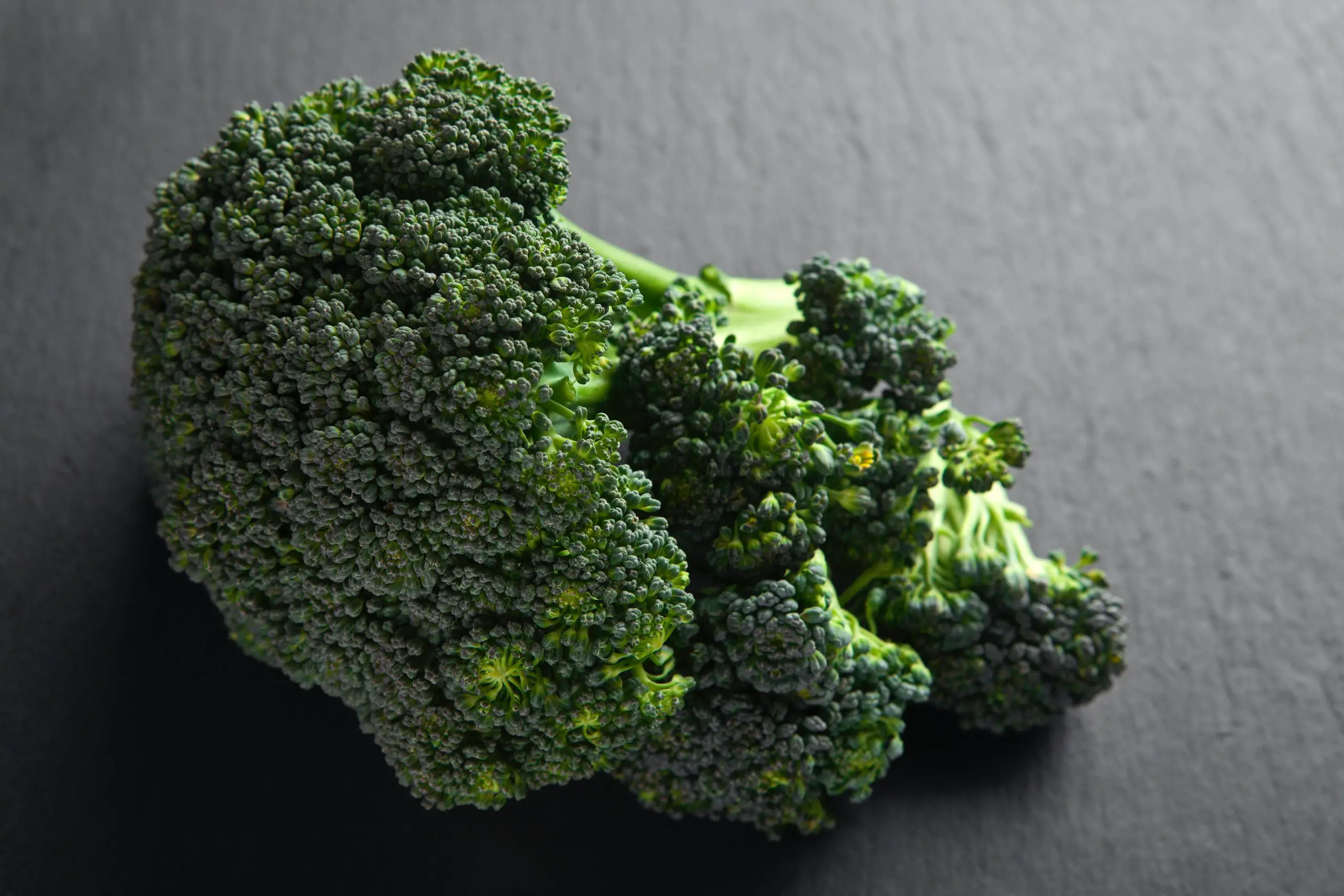Broccoli is a delicate vegetable that needs our complete attention to be preserved. It needs particular storage conditions to prevent deterioration and unfitness for eating. We’ll make a nice point: the refrigerator is the ideal place to store it. Do we need to know how to store broccoli properly in the refrigerator? Then read this post to learn the tricks and advice that will help you preserve all of its freshness for a few days.
The best way to store broccoli is to freeze or blanch it first. This ensures that it’s not too bitter. It is also important to check for signs of rotting. If you find dark spots on the florets, the broccoli may be spoiled.

What is Broccoli?
The enormous flower head, stem, and little accompanying leaves of the broccoli plant, Brassica oleracea var. Italica, which belongs to the Brassicaceae family and genus Brassica, is consumed as a vegetable. The cultivar group Italica of the species Brassica oleracea is where broccoli belongs.
Cauliflower, a distinct but related cultivar group of the same Brassica species, resembles broccoli. Large, typically dark-green flower heads on broccoli branch out from a sturdy, mostly light-green stalk in a tree-like arrangement. There are leaves all around the cluster of flower heads.
You can eat it cooked or uncooked. Vitamins C and K are very abundant in broccoli. Isothiocyanates and sulforaphane, two of its specific sulfur-containing glucosinolate molecules, are diminished by boiling but better preserved by steaming, microwaving, or stir-frying.
How to Store Broccoli in the Fridge?
The best way to keep broccoli and stop it from deteriorating too rapidly is in the refrigerator. However, the amount of time and manner in which broccoli is stored in the refrigerator will vary based on how it was cold.
The refrigerator is the best place to store raw broccoli to maintain its flavor and texture while preventing mold growth. If left at room temperature, its attractive green color will quickly become yellow, soften, and become unfit for ingestion; if put in the freezer, however, the cold will cause it to lose some of its nutritious value and texture.
You may also slightly clip the end of the stem and arrange your raw broccoli in a glass of water like a bouquet before placing it in the refrigerator. Take care to prevent the florets from soaking up water. Additionally, don’t forget to replace the water daily. Broccoli can be preserved using this way for 3–7 days. Again, broccoli keeps longer in the fridge; the fresher it is.
Avoid washing the broccoli florets before placing them in the refrigerator, and, if necessary, dry them thoroughly so that they are just moist but never soggy. Refrigerate raw broccoli as soon as you can to ensure longer refrigerator storage. When you get home from shopping, the best thing to do is to put it in the refrigerator!
How to Freeze Broccoli?
Broccoli may be preserved by blanching and freezing, regardless of whether you have a bumper crop from your garden, have stocked up at the grocery store, or found a fantastic deal at the farmers’ market.
The procedures to blanch and freeze broccoli are listed below, along with a comprehensive printable recipe, which can be found at the end of this page.
Harvest at its optimum or choose healthy crowns.
Harvest mature broccoli when the heads have reached their full size and are still compact, and before the blossom, buds have opened. Harvest broccoli in the early morning out the plant’s primary head several inches off the stem with a sharp knife or clean pruning shears. The plant will continue to develop side branches with smaller broccoli heads for a later harvest. Harvest broccoli in the early morning when the plants are well-hydrated and chilled from the nighttime air.
- Assemble your gear
- You’ll need the following standard kitchenware to freeze broccoli:
- Massive bowl
- Massive pot
- Mesh strainer or a colander
- Knife
- Chopping block
- Spoon with slots
- Baking pans
- Paper parchment Ziplock freezer bags
- Bathroom tissue
- Salt the Water and Soak the Broccoli
The crevices and crevices of broccoli make it challenging to clean off worms and bugs. To clear the broccoli’s surface of dirt and dust, give it a thorough rinse under warm, running water. By soaking the broccoli in salty water, any pests will be killed and helped to escape.
In a big bowl, combine 1 gallon of water and four teaspoons of salt to make a salt bath.
- Blach the broccoli
Broccoli is partially cooked when blanched in boiling water—this aids in slowing the enzymes responsible for the texture, color, and flavor loss. Additionally, blanching removes any germs that might be present on the surface.
Over high heat, bring a sizable pot of water to a boil. Create an ice bath by filling a big basin with ice and cold water while the water is heating up.
The broccoli pieces should be added to the boiling saucepan for three minutes.
Broccoli: Quickly Freeze Broccoli should be flash frozen before being placed in freezer bags to help avoid the pieces from adhering together and to make it easier to grab a handful as needed.
Dry the broccoli, then spread it out in a single layer on a baking sheet coated with parchment paper and freeze for approximately an hour or until it is solid.
- Package into freezer bags in step six.
Remove any air from the freezer bags before adding the frozen broccoli. When ready to use in your preferred recipes, label, date, and keep it in the freezer. Broccoli that has been blanched, wrapped, and frozen properly will keep for up to a year.
How to Defrost Frozen Broccoli?
Avoid letting frozen broccoli thaw out on the counter or in the refrigerator since it becomes soggy and becomes a mushy mess. This is most likely the main factor in the unfavorable reputation of frozen broccoli. After skipping this step, you can continue directly to your preferred way of cooking broccoli.
If you’re using frozen broccoli with other non-frozen ingredients, quickly steam it or put the florets in a bowl with hot water and let them sit for a few minutes before draining. The broccoli’s temperature will rise, ensuring equal cooking across the entire meal. The excess water in the broccoli can be absorbed with paper towels.
How to Reheat Broccoli?
Okay, now let’s discuss how to reheat those broccoli florets properly. In addition to having a pleasing color and flavor, broccoli must have a smooth texture. Broccoli that has been cooked should be soft enough to be eaten while maintaining a slight bite—a little bit like carrots. Therefore, be sure to undercook your broccoli by a few minutes if you’re cooking a large amount to bring to lunch for a few days. This will make it a bit rough, but as you reheat it at work, it will soften just enough.
In Microwave
The simplest, most practical, and most popular way to reheat almost anything is in the microwave. You will likely only be able to use the microwave in the lunchroom if this is a work lunch. In the microwave, broccoli cooked only halfway will soften perfectly. Here’s why: first, if you leave your broccoli dehydrated like that as it heats up, it will dry up and possibly burn at the edges; second, not everyone likes the fragrance of reheated broccoli. Ensure your broccoli is always stored in an airtight container with a lid.
In Oven
Electric ovens don’t dry out food as much as gas ovens. If you don’t want your cooked broccoli to dry out in the oven, place an oven-safe plate over it to keep the moisture in. Alternatively, you may put some tin foil on the top to achieve the same result. Additionally, don’t cover your broccoli if you want to dry it somewhat out. Since this approach takes longer than microwaving to heat the broccoli, be patient during the 10-15 minute heating period.
How to Recognize Broccoli has Gone Bad?
Presentation and Color
Does the broccoli appear tasty, or does something seem odd about it? It may appear limp, discolored, or wrinkled, indicating that the broccoli is spoiled. You also don’t want to see strange colors. Broccoli should always be green, so if the florets become yellow or brown, that’s a negative indicator. Toss the entire batch of broccoli if there are any obvious mold stains or if it appears mushy.
Aroma
Check with a foul odor. Broccoli should have a very faint scent that is vegetal and fresh. It might be past its peak if it smells highly of sulfur. It is never a good omen if you open the refrigerator with a foul odor.
Texture
Broccoli florets and stems should have a crisp texture. The stalk is a surefire indicator of a poor bunch if it feels limp or squishy. The florets are the same way. Keep an eye on the moisture content as well. A dry, cracked stem is undesirable, and wrinkles at the stem’s base are a sure sign that it has spoiled. The day will come when the broccoli needs to be thrown out once they begin to wilt.
What will Happen if you Eat too Much Broccoli?
Thiocyanate, progoitrin, and other substances found in cruciferous vegetables, such as broccoli, may impact thyroid health. According to the study in Nutrition Reviews, these naturally occurring compounds may reduce iodine absorption and, subsequently, the generation of thyroid hormone.
According to researchers, consuming an excessive amount of cruciferous vegetables, such as broccoli, can increase your risk of developing hypothyroidism. This condition causes unwanted weight gain, melancholy, lethargy, and aches and pains in the joints and muscles.
However, these negative consequences are unlikely to happen after eating regular servings of broccoli, collard greens, bok choy, cabbage, and other brassica vegetables. So, to activate myrosinase, an enzyme that breaks down these compounds, you can steam, boil, roast, or grill broccoli. Additionally, boiling lowers the levels of glucosinolates, particularly thiocyanate, according to a previous study published in Human Toxicology.
Depending on the environment, myrosinase can interact with GLS and hydrolyze it into isothiocyanate sulforaphane or sulforaphane nitrile, changing the content and concentration of GLS. Thus, boiling causes various chemical and physical changes to food, some of which include changing broccoli’s GLS and vitamin C content.
Because they are water-soluble, vitamin C and GLS are more likely to be lost while cooking. Despite some debate, most research suggests that both traditional (boiling, steaming, and frying) and unconventional (microwaving) cooking techniques significantly contribute to the deterioration of vitamin C and GLS. To better retain these two chemicals, steaming is the traditional approach that produces the greatest results.
Conclusion
How do you store your favorite greens in a cool and dry environment without overcooking them or wreaking havoc on your palate? Well, there’s a small trick. The trick is to keep your veggie tray in the fridge at a cool temperature, not hot or lukewarm. After that, it’s a matter of the right-sized plastic containers and a little elbow grease. This is a surefire way to keep your veggies fresh for longer.
Keeping your fridge at a cool temperature will also lower overall heating costs, saving your wallet and ensuring you get a well-deserved snooze on rare occasions.
